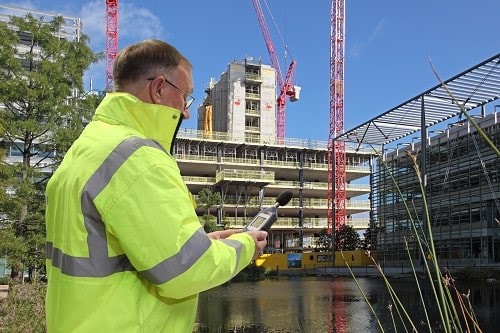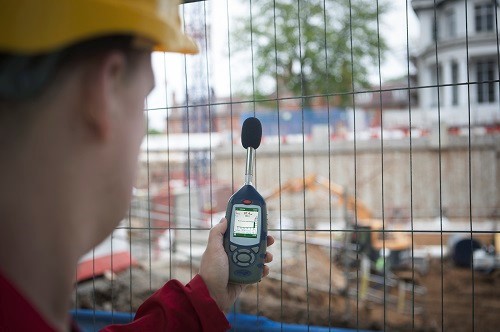Personal noise dosimeters and sound level meters can provide a picture of noise exposure and sources within a workplace.
Features
Measure Up
The images associated with a ‘workplace injury’ are dramatic and visual – falls from height, machinery crush injuries, chemical burns; all such serious injuries warrant due care and precautions from employers and workers. However, an equally serious and pervasive type of workplace injury is a much less visual one. In fact, it cannot be seen at all.
Noise-induced hearing loss (NIHL) is a permanent condition resulting in life-changing injuries that can seriously impair a worker’s quality of life. World Health Organization figures indicate that noise exposure contributes to 22 per cent of workplace-related health issues (bit.ly/35RsJQy).
 Personal noise dosimeters and sound level meters can provide a picture of noise exposure and sources within a workplace
Personal noise dosimeters and sound level meters can provide a picture of noise exposure and sources within a workplace
In the UK alone, HSE statistics suggest that more than one million employees are exposed to levels of noise at work which puts them at risk of NIHL (bit.ly/2XObtae). In 2018/2019, it was estimated that 21,000 workers suffered from work-related hearing problems, including hearing loss.
NIHL can lead to long-term consequences that can affect life both inside and outside of the workplace. Sufferers face social isolation and increased anxiety due to impaired communication and are put at greater risk in the workplace due to a decreased ability to monitor the workplace environment for audio cues warning of a potential hazard, such as alarms or machine noise.
Also, as the conversation around health and safety has turned to encompassing mental health and wellness, the impact of hearing loss on mental health cannot be understated. In fact, research has shown that a person with mild hearing loss is three times as likely to experience depression, and someone with more severe hearing loss is five times more likely.
It must be remembered that NIHL is preventable. The figures serve to reinforce that, despite increases in health and safety culture and committed legislation around workplace noise – namely the Control of Noise at Work Regulations 2005 – it is vital that employers and employees alike understand and commit to the need for an effective programme of noise monitoring and control measures. This relies on two key elements – training and tools.
Training
Whether conducted in-person or in a digital format, courses that provide a firm grounding in the mechanics and methodology of noise exposure and monitoring are the foundation of any comprehensive workplace programme.
 SLMs provide highly accurate static spot-readings of noise sources and individuals
SLMs provide highly accurate static spot-readings of noise sources and individuals
From covering the basic biology of how the ear reacts to and can be damaged by sound, courses should also cover topics including the parameters and terminology of noise and monitoring and legislation surrounding noise at work. Instruction on the practical use of instrumentation – such as noise personal dosimeters and sound level meters (SLMs) – should be a core component of training, alongside how they are calibrated, and how to calculate and interpret the results accurately.
Tools
To provide a comprehensive picture of noise exposure and sources within a workplace, two main tools are used – noise dosimeters and SLMs. Dosimeters are body-worn monitoring devices that are used to give readings of workers’ noise exposure as they undertake their daily tasks. SLMs provide highly accurate static spot-readings of noise sources and individuals.
SLMs are hand-held devices, enabling measurements to be taken at ear level with the instrument pointing at the noise source. If workers are likely to be exposed to high levels of impulsive noise, emitted from heavy pressing operations or sheet metal working, peak noises must be measured for accurate results and compared to peak action levels. Data captured by SLMs can also be used to demark noise control areas and select appropriate hearing protection and attenuation.
Highly mobile workers can employ a small body-mounted noise dosimeter to collect individual exposure data. Employees wear dosimeters for a full shift and data is logged instantly. When downloaded onto another device, details of the time history of the noise exposure can be reviewed, highlighting where and when high exposures occur throughout the day.
Advances, including Bluetooth connectivity and partner software or apps, allow safety managers to record, download and interpret data from units remotely, without needing to interrupt workers during their duties. This has become especially vital as a result of mandatory social distancing measures instigated across many workplaces as a result of the Covid-19 pandemic. This technology allows safety managers and employees to monitor their exposure to noise hazards and safeguard auditory health while remaining compliant and reducing the possibility of virus transmission.
Two key things to take away: ‘knowledge is power’ and ‘have the right tool for the job’. These are not the end of the story, of course. Though you may know the exposure of an individual, it then becomes about how it is used to provide the right controls, ensuring that NIHL does not occur in the workplace.
Tim Turney is Technical Product Manager at Casella
FEATURES

Sedentary working and how to combat the ‘sitting disease’
By Gavin Bradley, Active Working on 05 April 2024
Prolonged and excessive sitting poses a major risk to our health, but the Get Britain Standing campaign and On Your Feet Britain Day on 25 April are a great way of encouraging workers to sit less and move more.

Company culture and wellbeing: a crucial link
By Bex Moorhouse, Invigorate Spaces on 05 April 2024
Investing in measures to support worker wellbeing will be ineffective unless the company culture genuinely incorporates values like teamwork, involvement, flexibility and innovation.

Office design and culture: happier and healthier staff – or the opposite?
By Guy Osmond, Osmond Ergonomics on 03 April 2024
Applying ergonomic principles to workstation set-ups and ensuring the physical environment supports neurodivergent people are just some of the ways of creating an office where everyone can thrive, but a supportive and positive organisational culture is vital too.


